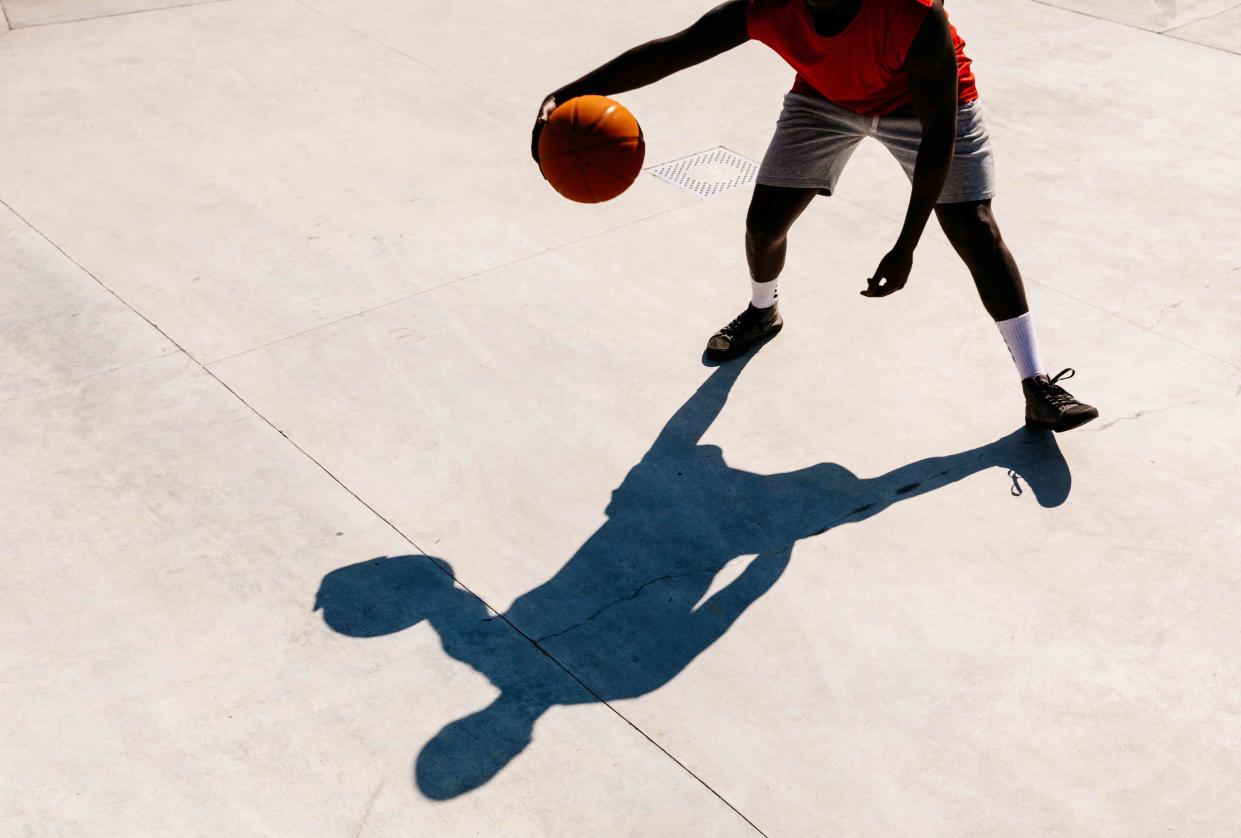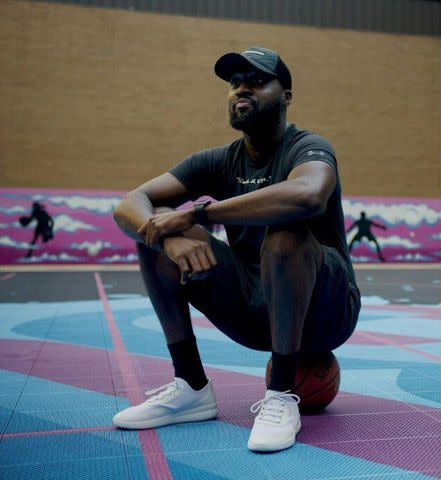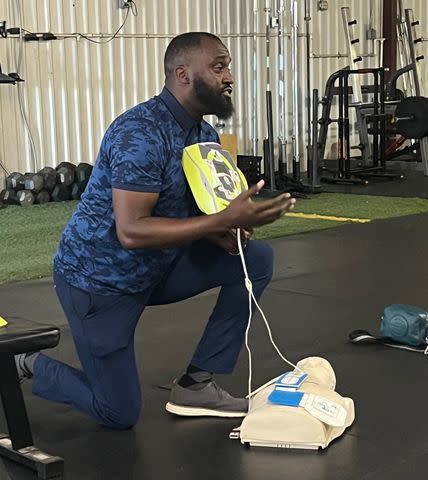Young, Black Athletes Have a Higher Risk of Sudden Cardiac Arrest—Here's One Survivor's Story
Omar Carter had NBA dreams, but an on-court cardiac arrest at just 25 years old changed his life—and gave him a new purpose.

Hello Africa / Getty Images
Fact checked by Nick Blackmer
The last thing Omar Carter remembers from July 9, 2013, is pulling up to the gym for his basketball game. The rest of the day is a blur—he’s only able to piece together what happened from personal accounts of teammates and bystanders, and a recording of the moment his heart stopped.
The video shows Carter, then 25, playing in his Pro-Am game. He’s shown dribbling down the court and passes the ball to a teammate to make a lay-up. After the pass, Carter backpedals and falls flat on his back.
Carter’s cardiac arrest—the sudden stopping of his heart—didn’t happen like he’d seen in movies or other videos. “I [vaguely] remember trying to catch myself, which was kind of odd,” Carter, now 36, told Health. "I've watched other sudden cardiac arrest videos where they kind of just drop; it was almost like I was aware."
Initially, bystanders and teammates thought Carter had just passed out, but two women—Kelly Thomas, an ICU cardiac nurse; and Claudia Ward, who would eventually become Carter's mother-in-law—knew something more serious was going on.
Ward and Thomas both performed CPR on Carter as they waited for others to get the facility’s automated external defibrillator (AED) and for the ambulance to arrive. Thomas shocked Carter three times; on the third, he gasped for air—his heart had stopped for a total of 13 minutes.
“[I was told] I gave this dramatic, kind of cinematic breath back to life,” said Carter. Just moments later, EMTs arrived. They put him in a medically induced coma and took him to Carolina Medical Center, where he woke up a few days later.
With his brain function intact, Carter gave doctors more than just his name when asked. “My first three questions were: ‘Have we prayed?’ ‘What day is it?’ and ‘Can I still play basketball?’” he said. But when Carter learned he had a cardiac arrest, he also learned his basketball career was over.

Omar Carter
A Love of Basketball and an ‘Athlete’s Heart’
Basketball had always been at the center of Carter’s life. He grew up playing with good friend and NBA star Steph Curry in their hometown of Charlotte, North Carolina, and played basketball in college at both Charleston Southern University and Appalachian State.
At the time of his cardiac arrest, Carter was an elite athlete, playing games in both Brazil and the U.S. He was often logging two-a-days—waking up in the morning to get a workout in, playing a pick-up game with friends, taking a nap, and then playing another Pro-Am game [a league in which professional and amateur athletes play alongside each other] in the evening. “I was really just trying to get my cardio together,” said Carter.
Carter had a clean bill of health, despite being told by a doctor that he had an “athlete’s heart” at 16. Though it’s not a true medical diagnosis, an athlete’s heart is the term given to any structural, functional, or electrical changes that accompany high-level athletic training.
"I gave this dramatic, kind of cinematic breath back to life."
Omar Carter
Carter was told he had an athlete’s heart after he started feeling pain in his left side during exercise. Once doctors identified that his pain was heart-related, he went through months of testing with “EKGs, ultrasounds, stress tests, MRIs,” said Carter.
Though there were concerns that Carter could have hypertrophic cardiomyopathy (HCM)—a condition in which the heart’s left ventricle becomes too thick and stiff to properly pump blood—he wasn’t diagnosed at that time. “[They said] it’s almost like you have checkmarks for hypertrophic cardiomyopathy, but you have more checkmarks for just an athlete’s heart,” said Carter.
He was told to watch and wait. He also got yearly cardiovascular exams, during which his cardiologist gave him the all-clear to keep playing basketball. Less than six months before his on-court cardiac arrest, Cater had one of those exams that showed he was still in good health. “They said, ‘Your heart muscle is not growing, you’re fine to continue to play,’” said Carter.
Then his on-court cardiac arrest happened. He was given a new diagnosis after that. “To this day, I am diagnosed with hypertrophic cardiomyopathy,” said Carter. “They think I could have had a bout of AFib [atrial fibrillation], so my chart says AFib and HCM.”
Related: Signs and Symptoms of a Cardiac Arrest
An Alarming Trend Among Black Male Athletes
Carter—along with other notable athletes like Buffalo Bills safety Damar Hamlin, USC Trojans guard Bronny James, and Oklahoma City Thunder forward Keyontae Johnson—is part of a larger group of athletes, often young Black men, who had a cardiac arrest despite seeming in good health.
The trend has piqued the interest of researchers, supported by the National Heart, Lung, and Blood Institute (NHLBI), who are looking into the apparent increased risk of sudden cardiac arrest (SCA) that young, male Black athletes seem to have.
“In young competitive athletes, epidemiologic studies have consistently shown that Black athletes are about two to three times higher risk than white athletes to suffer SCA,” Jonathan Drezner, MD, director of the UW Medicine Center for Sports Cardiology, told Health.
SCA is the leading cause of sport-related deaths among competitive athletes in the U.S., and Black male NCAA Division I basketball players have the highest risk, according to 2020 research published in the British Journal of Sports Medicine (BJSM). These players, compared to the average high school athlete, are 21 times more likely to suffer a life-threatening cardiovascular event.
"Black athletes are about two to three times higher risk than white athletes to suffer [sudden cardiac arrest]."
Jonathan Drezner, MD
The causes of these sudden cardiac arrests and deaths vary depending on age, but a large portion among college and professional athletes are due to cardiomyopathies, or disorders that affect the heart muscle. HCM, what Carter was diagnosed with, has caused just over 20% of SCAs, the BJSM study showed. HCM has not shown to be more prevalent in Black athletes, but because high-intensity exercise can be a trigger, they may have more exposure.
The research here is still unfolding, but experts believe Black athletes' higher risk is tied to the social, economic, and physical conditions disadvantaged populations live in. "It most certainly has something to do with social determinants of health, [and] psychosocial stressors, including racism and discrimination," said Merije T. Chukumerije, MD, FACC, RVPI, director of sports cardiology for the Smidt Heart Institute at Cedars-Sinai Medical Group, and team cardiologist for the LA Galaxy and LA Clippers.
“Our research has shown that Black athletes with SCA come from neighborhoods with greater socioeconomic deprivation than white athletes with SCA, but the mechanisms that lead to a higher risk need to be elucidated,” added Drezner, the corresponding author on the BJSM study. “These may include more access to healthcare, higher quality screening, more attention to cardiovascular symptoms or a family history of heart disease—all of which could lead to early detection of conditions at risk of SCA.”
The higher risk “speaks to what Black and brown people go through, whether it’s school disparities, whether it’s health disparities, whether it’s access to resources,” said Carter. He also highlighted the lack of access to fresh, nutritious foods in many disadvantaged communities, and reliance on highly processed meals, which has been linked to worse health outcomes.

Omar Carter
Brought Back to Life With a New Lease and Mission
To his doctors’ and family’s surprise, Carter didn’t have to go through much physical recovery following his cardiac arrest and brain injury after hitting his head on the court.
Soon after he left the hospital, Carter was given an implantable cardioverter-defibrillator (ICD), a battery-powered device placed under the skin that connects to the heart. “It’s just basically if I have an arrhythmia, or my heart goes out of whack, it’s going to shock me,” said Carter. “I have not had to use it, knock on wood.”
But there was still healing to do. “It was a lot of mental [recovery],” said Carter. When he left the hospital in August 2013, he was fairly depressed. “I was 25 years old, I [had] pretty much worked all my life for this,” he said of his basketball career. But not being able to play left Carter questioning his purpose in life. “I couldn’t watch basketball for a long period of time,” he said. “What I had planned, I couldn’t do it anymore.”
It wasn’t until his mother, Stephanie Tyson, suggested he start a foundation that Carter started to find his footing again.
The Omar Carter Foundation was founded in 2014 and gained 501(c)(3) nonprofit status in 2015. Its mission is to not only raise awareness about sudden cardiac arrest, but to train athletes and families in CPR and AED use, and educate people on all aspects of cardiovascular health.
"I couldn’t watch basketball for a long period of time...what I had planned, I couldn’t do it anymore."
Omar Carter
“At first it was just, ‘I want to teach CPR,’” said Carter. But 10 years in, the mission has expanded. “We teach them the bystander CPR piece, but we place AEDs as well.” The foundation also teaches people to use those AEDs in order to increase the number of bystanders at athletic events who are willing and able to jump in and save a life.
Carter also finds great pride in helping others navigate their survivorship, whether it’s following a cardiac arrest or other career-ending injury. He’s adopted more heart-healthy habits for himself, too. Prior to his cardiac arrest, Carter said he felt “invincible,” and while he didn’t make any immediate changes following that life-changing event, a “benign” bout of AFib in 2019 spurred healthy lifestyle changes.
Carter now follows a plant-based diet for the heart-health benefits, and prioritizes drinking enough water, keeping his stress levels in check, and exercising in a way that’s safe for him, as a cardiac arrest survivor (this means keeping track of his heart rate during physical activity to make sure it doesn’t go above 150 beats per minute).
Though his life may not have turned out the way he planned at 25 years old, he believes he’s still fulfilling his mission through the work of his foundation and sharing his story. “It’s helped me because I’m effectively doing what I thought I would do...just in a different way,” Carter said. “I may not be on the basketball court, but I’ve always had a passion to touch lives and give back.”
For more Health.com news, make sure to sign up for our newsletter!
Read the original article on Health.com.
